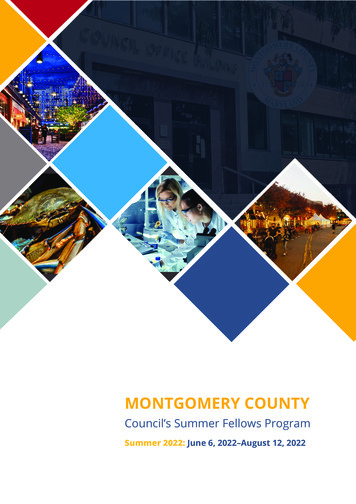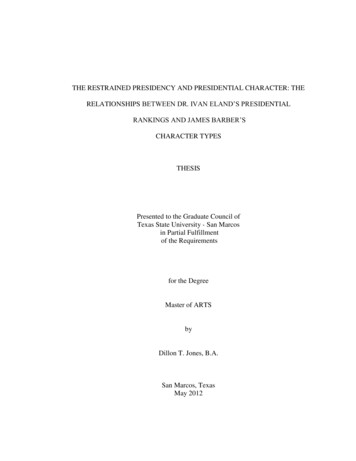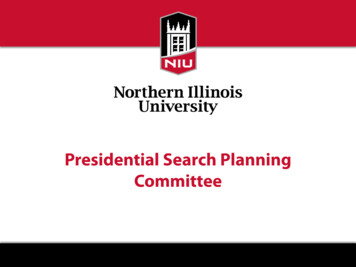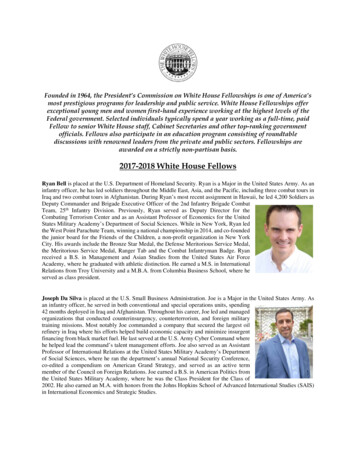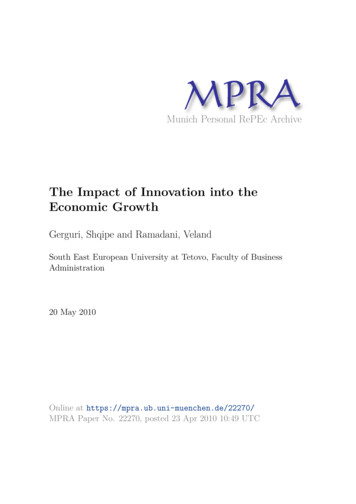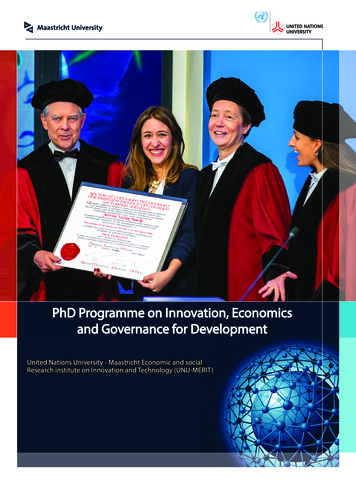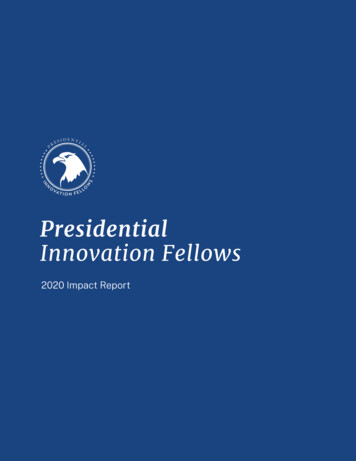
Transcription
PresidentialInnovation Fellows2020 Impact Report1Presidential Innovation Fellows 2020 Impact Report
2Presidential Innovation Fellows 2020 Impact Report
Table ofContentsPage 4About UsA message from our Executive DirectorOur missionOur valuesOur journeyPIF by the numbersPage 13Big PictureInnovating in times of crisis: product lessons from COVID-19Reducing the burden on veterans and their careproviders through chatbots and modern digital toolsAccelerating telehealth awareness and adoption duringthe COVID-19 pandemicInteragency innovation: operationalizing CXgovernment-widePage 20Page 393VAHRSA,HHSOMBFellow ProjectsAdvancing safe, efficient intelligent transportation systemsDOTAchieving continuous ATO using DevSecOpsUSNDriving human-centered cultural transformation andworkforce resilienceCMSSpurring long-term economic growth by supportinginnovators and entrepreneurs worldwideMCCUsing data from wearable sensors to discover relationshipsto healthNIHUnlocking the value of dataFDAUsing machine learning to deliver veterans’ benefits fasterVATurning data into knowledge with enterprise data & analyticsVAIncreasing veterans’ trust using human-centered designVALooking AheadPresidential Innovation Fellows 2020 Impact Report
About us4Presidential Innovation Fellows 2020 Impact Report
A messagefrom ourExecutiveDirectorPresidential Innovation Fellows (PIF)unites industry’s brightestWe need to act today to solvetechnologists with forward-thinkingtomorrow’s challenges. We facefederal leaders to improve the way ouremerging opportunities and tomorrow’sgovernment builds, designs, andthreats with our visionary and tacticaldelivers services for all Americans.expertise today. Consider the profound2020 was a challenging year, and weremain as dedicated as ever to our work.Here are the 2020 results we delivered,the lessons we learned, and the visionwe’re taking into 2021. I’m proud of whatwe’ve done with our partners this year.We’re stronger together. There is nosingle “hero” in our work. We exist tobuild bridges. With our newest PIFcohort, we’ve embedded 34 of thenation’s top technologists in 22 federalagencies to work on 26 projects. Ourfellows also foster interagencymodernization, like digital telemedicineresources to help the public safely findthe care they need during thepandemic.We’re building a resilient digitalgovernment. Since 2012, PIF has playeda critical role in responding to nationalchallenges. We’ve served as firstresponders to healthcare.gov, andplayed founding roles in some of thegovernment’s more advanced digitalcapabilities. Throughout COVID-19, PIFshave been on the front lines of the civictech response with fellow publicservants. PIF helped launchtelehealth.hhs.gov with leaders acrossimpact that artificial intelligence (AI) isalready having in government. PIF’s AIwork helps deliver veterans’ benefitsfaster, counter hiring biases, protecthuman health and the environment,advance COVID-19 diagnostics, andmore. With this year’s Executive Orderon Promoting the Use of Trustworthy AIin the Federal Government, weformalized our commitment to unitemission-driven data science, AI, andmachine learning experts with federalleaders to design, develop, and deliverAI for public good.Our commitment is stronger than ever.Every year, we recruit the best datascientists, engineers, designers,product leaders, and entrepreneurs intogovernment. They’re eager to join us.These tours of service often extend farbeyond our program. More than 50% ofour fellows take technical leadershiproles within government aftergraduating from our program, ensuringour civil servants’ digital expertiseendures and grows.The work continues. It’s the honor of alifetime to contribute to a modern,trusted government for all.HHS, HRSA, and OSTP to provide plainlanguage telemedicine resources to1M health care providers and millionsof patients across the United States. We5also led the development of aJoshua Di Francescoronavirus chatbot to address the VA’sExecutive Director,rising call center wait times.Presidential Innovation FellowsPresidential Innovation Fellows 2020 Impact Report
Our missionWe’re proud to be part of GSA’s Technology TransformationServices (TTS). TTS’ mission is to design and deliver a digitalgovernment with and for the American public.Our missionEmbed industry’s brightest technologists, entrepreneurs, andinnovators within federal agencies to improve the way ourgovernment builds, designs, and delivers services.Who we arePIF is committed to representing the diversity of the publicwe serve. We’re a multidisciplinary team of productdesigners, full-stack engineers, and venture-backedfounders. We’re also artists. Parents. Immigrants. Veterans.As a team, we all share a passion for civic purpose—people helping people.What we doWe unite private-and public-sector innovators to build bold solutionsfor public good. Hand-in-hand with federal agency leaders, we identifyDepartment ofDefenseHomelandSecurityInnovation Unit((I\a-1: ' 'o .,."fH artmentofnteriorDepartment ofTransportationFederal Bureauof InvestigationDefenseopportunity with critical agency and/or national priority. Every year,IllFood and DrugAdministrationFDIGFederal DepositInsuranceCorpor-ationfjlt., f.,.,Health andHumanServicesInternalRevenueService3' FE1FederalEmergencManagemt'Agenq./ 'Services''ionPIF projects that will make an impact. Each project is an innovationDepartment ofOepartmrI,·our team recruits outstanding private-sector talent into our program.PIF embeds the nation's top technologists, designers, and strategistswithin agencies as yearlong entrepreneurs in residence. With ouragency partners, our fellows advise, rapidly prototype, and scalesolutions using industry best practices across data science, design,engineering, product, and systems thinking. Our fellows serve as bothstrategic advisors and practitioners who build, test, and ship solutions.6Presidential Innovation Fellows 2020 Impact Report
Our valuesDesign with the publicFocus on serviceWe create products and servicesWe don’t build tech for tech’s sake.with users, not for them.We co-create solutions to enrich thelives of the public.Be courageousStay curiousWe do what is right for the peopleWe are lifelong learners who bringeven, and especially, when it is hard.empathy and humility to e inclusionGrow togetherWe recognize and celebrate whatWe make our agency partners,makes each of us uniquely brilliant.alumni, and collaborators succeed.Every day, we work to foster aCommunity is at the center of allculture of belonging where everyonewe do.can do their best work.7Presidential Innovation Fellows 2020 Impact Report
Our journeySince our founding in 2012, 190 fellows have worked with 45 agency partners, improving and modernizing government servicesfor hundreds of millions of Americans.Here’s our journey timeline:2012 U.S. CTO Todd Park co-creates the PIF program within theWhite House Office of Science and Technology Policy(OSTP) to attract top innovators into government who cantackle issues where technology, policy, and processintersect.PIF joins the U.S. General Services Administration (GSA) 2013family to further innovation across government.PIF also serves on the team that addresses thehealthcare.gov launch.2014 PIF alum Ryan Panchadsaram becomes U.S. Deputy CTOunder Todd Park. PIFs co-found and help start digitalservices: In March, PIF alumni co-found 18F, a digital design anddevelopment shop within the federal government. In August, PIF alumni are on the founding team of theU.S. Digital Service (USDS), a program that deployssmall, responsive groups of designers, engineers, andproduct managers to work with and empower civilservants.President Barack Obama makes the PIF program 2015permanent through Executive Order 13704.2016 PIFs partner with the National Cancer Institute as part ofVice President Biden’s Cancer Moonshot Initiative to helpredesign how people think about, find, and participate incancer clinical research.8Presidential Innovation Fellows 2020 Impact Report
Our journeyPresident Obama codifies the PIF program into law by 2017signing the TALENT Act, which passed 100-0 in the Senate.2018 PIF alum Michael Brown becomes Director of the DefenseInnovation Unit. As a PIF at the Department of Defense(DoD), he co-authored Pentagon study on China’sparticipation in the U.S. venture ecosystem, a catalyst forthe Foreign Investment Risk Review Modernization Act(FIRRMA). FIRRMA was signed into law in August 2018 andprovided expanded jurisdiction to the Committee onPIF grows to 40 fellows and 20 agency projects, expandingForeign Investment in the United States (CFIUS).our work and collaboration across government. PIFs alsopartner with the White House Office of Management andBudget on the Customer Experience (CX) Cross-Agency 2019Priority (CAP) Goal effort to provide a modern, streamlined,and responsive customer experience across government.2020PIFs rally to serve the public and frontline workersPIF grows 70% year over year to 62 fellows working on 42throughout the COVID-19 pandemic, developing telehealthprojects at 25 agencies as we announce our newest classresources, coronavirus chatbots, precision medicineof 34 fellows, 45% of whom bring deep expertise in dataresearch, crowdsourced childcare, screening apps, andscience and AI.more.Civic tech grows globally! The United Kingdom launchesThe White House signs the Executive Order (EO) onthe No.10 Innovation Fellowship Programme to lead newPromoting the Use of Trustworthy AI in the Federalproducts and services in areas such as healthcare, veteransGovernment, which establishes the first-ever commonsupport, and natural disaster relief, noting inspiration fromprinciples for using AI in the federal government. The EOthe U.S. Presidential Innovation Fellows program.also directs agencies use the PIF program to enhance AIexpertise in government.9Presidential Innovation Fellows 2020 Impact Report
Showing up for our partners, our community, and the public10Presidential Innovation Fellows 2020 Impact Report
PIFby the numbers11Presidential Innovation Fellows 2020 Impact Report
PIF by the numbersOur team6247%47%current Presidential Innovation FellowsPeople of color25Womenfederal agency partners in 2020Expertise brought into government in ourlatest cohort:42current projects190 industry leadersin technology, design, and strategy brought intogovernment by PIF since 201253%of PIFs continue in government rolesafter graduating from our programProduct ManagementHuman-Centered DesignEntrepreneurshipData Science (AI/ML)ResearchChange ManagementPortfolio ManagementEmerging TechSoftware EngineeringProduct Design (UX/UI)Digital MarketingCloud & 018171615151515Our impact2 million 130K 175COVID-19 screenings for VA patientsand employeesuser sessions with VA coronaviruschatbot, helping care providers focuson urgent issuesindustry COVID-19 response offerstriaged for White House 2 weeks17x100 partnersfrom idea to launch fortelehealth.hhs.gov, serving 1M health care providers and millions ofpatientsmore digital benefits applicationsfrom veterans, processed 3-5 daysfastercommitted to using the U.S.Department of Transportation CARMAPlatformSM (Cooperative AutomationResearch Mobility Application) 1.5 million 7x24%direct labor cost savings for VAfaster authority to operate (ATO)across the Naval enterpriseincrease in trust in the VA amongveterans12Presidential Innovation Fellows 2020 Impact Report
Big picture13Presidential Innovation Fellows 2020 Impact Report
Big Picture: COVID-19 ResponseInnovating in times of crisis:Product lessons from COVID-19When PIF welcomed our 2020 cohort in October 2019,we did not anticipate the pandemic. For us, it turnedout to be a call to step up and serve the U.S. people ina time of need. We prioritized helping agenciesrespond to COVID-19 by building new digital servicesthat addressed public needs. We worked within andacross agencies to build digital response effortsacross FDA, NIH, VA, HHS, HRSA, OSTP, CMS, andmore.With the U.S. Department of Health & Human ServicesThese constraints led us to ask ourselves: How do we(HHS) and the Health Resources and Servicesinnovate faster and cultivate a culture of rapidAdministration (HRSA), PIF led the launch ofprototyping and iteration in the government? Moretelehealth.hhs.gov, a website that centralizesimportantly, how do we build useful digital servicestelehealth policy updates and resources for healthquickly without compromising quality and value?care providers and patients. Our PIFs detailed to theVA led the launch of the VA coronavirus chatbot toprovide veterans information on COVID-19’s impact ontheir VA benefits and services, as well as a VACOVID-19 screener tool that helps assess COVID-19risk factors at VA medical centers’ building entrances.Despite intense timelines, we ended up launching newdigital products and services from ideation toproduction in less than two weeks. Lean and agileproduct development proved to be more essential thanever in these constraints. Product managers andtechnologists can apply these lessons to effectivelyDeveloping products during this time of crisis wasbuild products and services and bring them touniquely challenging for a few reasons:production quickly. Every problem we came across was urgent insome way Visibility and scrutiny on work delivered washigher than usual Start by digging into the problem spaceBuild a strong coalition of support andThe appetite for risks and tolerance for “hiccups”partnerships—especially with those on the frontwas very lowlinesResults needed to be delivered “yesterday”We were working 100% remote for the first timewhile coming together as new teams14In this Digital.gov blog, we dive deep on our learnings:Presidential Innovation Fellows 2020 Impact Report Build your team small to stay nimbleDon’t let perfect be the enemy of good
Deep Dive: COVID-19 ResponseU.S. Department of Veterans Afairs (VA)Reducing burdens on veterans and careproviders through chatbots and moderndigital toolsThe challengeThe impactThe COVID-19 pandemic led to a surge in calls to VA’sAs of December 1, 2020, the VA coronavirus chatbotcontact centers and other communication channels.has seen 130K user sessions. Top categories forVeterans and their caregivers were—and are—veteran questions include:concerned about COVID-19 and how VA’s responseaffects their existing VA healthcare and services. Theincreased call volume (up to three hours) led tofrustrating hold times for veterans, staffingchallenges, and delayed access to clinical expertisefor callers with an urgent healthcare need. COVID-19 testing at VAHealthcare, appointments, and prescriptionsMy current COVID-19 symptoms (CDC selfchecker tool)Fewer than 4% of user sessions end with the veteranchoosing to “talk with someone about [their] specificThe solutionneeds” (i.e. connect with a call center). This resultsuggests that the chatbot may be effectively divertingFor veterans who need information about COVID-19calls from VA call centers.and how VA’s response affects their healthcare andother services, VA’s coronavirus chatbot is aninteractive, web-based digital tool to better serve thisFeedback from veteran user testing sessions andsurveys suggest that veterans enjoy interacting withincreased demand for information during theVA through this type of digital tool. Given thepandemic. The Digital Experience Product Officepromising results so far, the VA Office of the Chiefwithin the VA Office of Information and Technology, inTechnology Officer is now exploring more use casespartnership with PIF, the Veterans Healthfor interactive digital tools.Administration Office of Community Care, and theVeteran’s Experience Office, developed this tool.12:17Q Va.govThrough user research, including deep dives with VAcall centers and multiple rounds of interviews withveterans, the team learned that most of the calls wereabout a handful of the same, VA-specific frequentlyasked questions related to COVID-19. One examplewas, “how can I switch my scheduled VA healthcareappointments to telehealth appointments?” The VAand PIF developed the chatbot as a way to give thisinformation to veterans without requiring a phone call.15Presidential Innovation Fellows 2020 Impact Report HomeVA coronavirus chatbotGet answers to your questions about thecoronavirus and VA benefits and services below.
Deep Dive: COVID-19 ResponseHealth Resources and Services Administration (HRSA),U.S. Department of Health and Human Services (HHS)Accelerating telehealth awareness andadoption during COVID-19The challengeThe solutionDuring the global COVID-19 pandemic, digital healthTo address this challenge and expand telehealthbecame increasingly important. When people seek in-capacity to meet the spike in demand for safe virtualperson medical care, they risk exposure forcare, PIF led the development and launch ofthemselves, their family, other patients, and healthtelehealth.HHS.gov, a government website thatcare providers. As a result, brick-and-mortar medicalprovides helpful information about telemedicine infacilities are also offering telemedicine. Responding toplain language, and links to tools and resources forthis challenge, the U.S. government made historichealth care providers. It also uses U.S. Web Designstrides by deregulating telehealth. However, policySystem (USWDS) to easily adopt the latest web designinformation and the impact on the public was notstandards.available on a centralized HHS website, norcommunicated in plain language. This thwarted fastadoption of telehealth for both providers and thepublic.Bringing together leaders and subject matter expertsfrom HHS, HRSA, OSTP, FEMA, and ASPR, PIFenvisioned the project, articulated user needs, andsecured sponsorship for a timely execution, launchingthe site from inception to production in less than twoweeks.An official website of the United States government Here's how Y.Ouknow v0If you're having a medical emergency, call 911. If you aren't sure, read when to seek emergencY. care.TELE HEALTH.HHS.GOVAbout usFor patientsvFor providers—v 2 weeksfor website launch, frominception to productionLearn more about telehealth16 For patientsFor providersFind out what telehealth is, what you'll need (notGet information to help you integrate telehealth andmuch!), and what to expect from a visit. You can alsoget up to speed on recent COVID-19 changes tocheck out our tips on finding telehealth options.policies and billing and reimbursement.Presidential Innovation Fellows 2020 Impact Report
Deep Dive: COVID-19 ResponseHealth Resources and Services Administration (HRSA),U.S. Department of Health and Human Services (HHS)Accelerating telehealth awareness andadoption during COVID-19The impactThe website actively serves thousands of users andhas seen a positive response across the telehealthcommunity. The core team remains committed to“The Presidential Innovation Fellows wereessential to telehealth.hhs.gov. PIF Likhithamobilizing a strong telehealth workforce to help keepPatha’s leadership delivered a comprehensiveAmericans healthy through and beyond thistelehealth website where, for the first time,challenging time, with this effort finding a long-termhome and funding in HRSA’s Federal Office of Ruralpatients and providers could get theHealth Policy and Office for the Advancement ofinformation they needed to access andTelehealth.provide care. PIF Dennis Chornenky wasBuilding on this work, PIF worked with White Houseinstrumental in ensuring our private-sectorcolleagues on the White House launch of the Pledge topartners were taking the right steps to provideEmbrace Technology to Advance America’s Health.virtual care across the country. The PIFs50 of the nation’s largest health insurance plansand stakeholders committed to expand telehealthcoverage and adoption.This move helped reassure Americans that telehealthis here to stay. When patients can get healthcarethrough telehealth—and doctors can provide it—weprotect ourselves and our communities. Our digitalapproach helps keep providers and patients safe andhealthy for the long run.17Presidential Innovation Fellows 2020 Impact Reportstepped up and in to drive innovation withHHS at a crucial time and it is a model of howsuccessful collaboration across governmentshould occur.William Brady Chief of Staff to the DeputySecretary and Senior Advisor to the Secretary atHHS
Big Picture: Interagency InnovationInteragency innovation:Operationalizing CX government-wideThe challengeThe solutionOn multiple satisfaction indices, the U.S. federalAs a part of the CX CAP Goal core team, PIF isgovernment lags behind all industries. Trust ininstitutionalizing industry-level customer experiencegovernment is declining to near-historic lows. The 2018rigor including:President’s Management Agenda prioritized customer Incorporating CX best practices from the privateexperience (CX) effectiveness to improve servicesector, including new performance metrics, intodelivery and foster trust. The Cross-Agency Prioritygovernment-wide guidance documents like OMB(CAP) Goal team (co-led by OMB, VA, and USDS)Circular A-11 Section 280sought to operationalize customer experience Launching Touchpoints, an easy, low-barrier toolmanagement in an environment lacking the growthto help agencies begin surveying customers, andand competitive imperatives that drive CX in theworking with them to identify when and howprivate sector.they’ll collect feedbackCustomer experience is an individual’s perception oftheir collective interactions with an organization orbrand. A federal service is defined as the sum of the Creating and leading multi-day trainings onservice definition and management Using these trainings to show how servicedefinition and management can reflect 21ststhelp provided—by an agency and its partners—Century Integrated Digital Experience Act (IDEA)throughout the process a customer goes through toprioritization of services to digitize at Highobtain, receive, or use a public offering (or comply witha policy). Customers perceive the series of interactionsas a whole when they combine to solve a need.Impact Service Providers (HISPs) responses per quarter from more than 20 federalprogramsThe degree to which those interactions are effectivelycoordinated (across levels and agencies ofProcessing more than 1.1 million survey Cleaning, analyzing, and gleaning actionablegovernment), easy to navigate, and reduce uncertaintyinsights to inform more than 200 federal programlargely determines customer satisfaction and trust.managers government-wide and working withAgencies measure the degree to which differentmany of them to understand, learn from, and actdrivers — transparency, equity, speed, efficiency,on their own resultseffectiveness, and employees — contribute to theiroverall experience for different types of services. Developing an even more simple, streamlinedapproach for federal agencies and services incollecting feedback data for the 2021 A-11Section 280 guidance in line with improvedmethods from leading organizations18Presidential Innovation Fellows 2020 Impact Report
Big Picture: Interagency InnovationInteragency innovation:Operationalizing CX government-wide Piloting an agency-agnostic, more service-improving how our government understands andlanguage processing, machine learning, andresponds to public feedbacksocial listening and comment box data activities, such as their CX capacity assessments,and develop action plansConducting a Federal CX and Service Deliverystrategy sprint to identify transformative actionsthat inform the 2021 President’s ManagementAgendaThe impactIn a survey of nearly 100 HISP federal program100% completion of HISPs’ CX capacityassessments and action plans (and public releaseProviding ongoing advisory support to HISPs ason performance.gov/cx)they conduct customer outreach and research 10x increase in Touchpoints product usage,oriented approach to conducting naturalother sophisticated techniques for learning from The momentum generated deep within many of thenation’s highest impact programs — touching the livesof nearly every individual living in the United States —will help lead to a more human-centered, responsivegovernment.“The PIFs supporting our team have broughtsuch incredible experience to bear – providingleaders, more than 80% strongly agreed that defininga new level of credibility with Federalcentral CX measures, establishing the A-11 280agencies – to inspire change and worthinessguidance, and providing a central support team hadhelped them improve their services. This includesof these eforts. Their willingness to dive in,establishing annual routines to define federaldo everything from data analysis toservices, evaluate maturity against leading practices,facilitating workshops with executives, islisten to customers, and from this, commit to action.This, with a central PIF team supporting and coaching,provides a critical foundation to build upon: 2x increase in agency participation and HISPquarterly data submissions, and many HISPscollected customer feedback for the very firsttime19Presidential Innovation Fellows 2020 Impact Reportgame changing.Amira Boland Federal Customer ExperienceLead, Office of Management and Budget
Fellow projects20Presidential Innovation Fellows 2020 Impact Report
Fellow ProjectsU.S. Department of Transportation (DOT)Advancing safe, efcient intelligenttransportation systemsThe challengeThe solutionWith the increasing maturity and application testing ofCARMA PlatformSM (Cooperative Automation Researchautomated and robotic technologies forMobility Application) focuses on a critical area oftransportation, the DOT Intelligent Transportationcollaborative mobility research for surface-levelSystems Joint Program Office (ITS-JPO) and the Turnerautonomous systems. On behalf of the ITS-JPO withinFairbank Research Center (TFRC) have been activelythe CARMA project, the PIF serves as its chief strategyresearching safe and efficient ways to implementofficer managing project-wide strategy, engagementthese technologies.with public and private stakeholders, and technicalAlthough there is private-sector funding fordevelopment pathways.autonomous vehicles, there is a significant gap inCARMA is developing an open-source softwaretechnology research for how multiple andplatform for multiple autonomous driving systems todifferentiated autonomous systems can safely andcommunicate, negotiate, and operate seamlesslyefficiently co-exist and interact with one another. Wetogether. The research is currently split into threeneed a broader ecosystem view and multiplemajor workstreams: software simulation, prototypingconnected and automated transportation systemsof small-scale vehicles (1/20th), and full-scale (road-platform to address a looming market failure.ready) autonomous vehicle research.21Presidential Innovation Fellows 2020 Impact Report
Fellow ProjectsU.S. Department of Transportation (DOT)Advancing safe, efcient intelligenttransportation systemsThe impactIn only a year, CARMA has successfully attracted over100 project partners who have committed to usingthe CARMA platform for collaborative autonomousresearch. It has received multiple grants from acrossthe department and state DOTs.CARMA’s impact is resonating and being reused inother agencies and programs. In several white papers,DOT’s Office of Research and Technology hasreferenced key lessons from the CARMA projecthighlighting the need for cooperation amongautomated vehicles to ensure higher levels of safetyand efficiency. Several DOT modal administrators(Volpe National Transportation Systems Center,Federal Motor Carrier Safety Administration, NationalHighway Traffic Safety Administration, etc.) havevoiced their support and funded major portions ofCARMA’s research.CARMA has successfully worked with industrystandards organization Society of AutomotiveEngineers to create standards for Cooperative DrivingAutomation under J3216, a document of taxonomy anddefinitions for terms related to cooperative drivingautomation for on-road motor vehicles.22Presidential Innovation Fellows 2020 Impact Report—100 partnerscommitted to using the CARMAplatform
Fellow ProjectsU.S. Department of the Navy (USN)Achieving continuous ATO usingDevSecOpsThe challengeThe Naval enterprise wanted to improve and scale itscloud usage, and more critically, how they write andship software to warfighters.PIF established an agile project management mindsetacross the agency, enabling frequent deliveries ofcustomer-prioritized features that offer meaningfulcapability, even in very small increments. Thesedeliveries embody a culture of continuous integrationWriting good software is difficult, and developing aand continuous deployment (CI/CD) by integrating thegreat app takes a team. Learning to code is only aintended security architecture and operations conceptsmall portion of digital transformation. The team andfrom the outset. The solution is a combination ofculture competencies aren’t obvious and aren't a partplatform operations, infrastructure as a service, ops,of any curriculum, especially those of DevSecOps.and security. Technology is purely an enabler to buildThis leaves a Naval enterprise in need of not justthe trust that this process not only works, but works intechnical expertise, but experience and leadershipa way that can be clearly understood, and where eachthat can only be earned through working in the techperson who touches it understands what they areindustry. Additionally, organizations like thecontributing, and why that’s valuable. At the heart ofDepartment of Defense have rigorous standards forBlack Pearl is a simple want: to enable culture change.the efficacy and security of their software, makingauthority to operate (ATO) a lengthy process(historically, most ATOs take around 18 months). TheNavy w
Civic tech grows globally! The United Kingdom launches the . No.10 Innovation Fellowship Programme . to lead new products and services in areas such as healthcare, veterans support, and natural disaster relief, noting inspiration from the U.S. Presidential Innovation Fellows program. 9. Presidential Innovation Fellows . 2020 Impact Report
